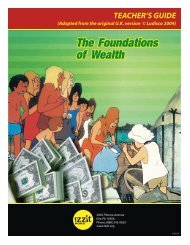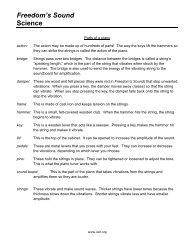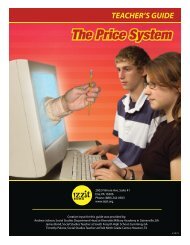Transcript - Izzit.org
Transcript - Izzit.org
Transcript - Izzit.org
- No tags were found...
You also want an ePaper? Increase the reach of your titles
YUMPU automatically turns print PDFs into web optimized ePapers that Google loves.
The Price System Part 1The Price System<strong>Transcript</strong>For a list of additional resources to use with this video go towww.izzit.<strong>org</strong>/products and click on The Price System video.EMILY: Oh, great…sounds boring as usual, too much information. Wait! "I the Pencil: ...economist...lecture gives a simple yet…”EMERSON: Simple? What have we found, Emily?EMILY: We? Sit down, Emerson, and "we've" found...FRIEDMAN: We need to understand how it is that a free market works to enable millions of people tocooperate peacefully together. I know no better way to bring this out than by a very simple example that Iowe to an old friend of mine, Leonard Read, who once wrote a little article called “I the Pencil.”PENCIL: I am a pencil, a commonly known implement….yet, I, Pencil, simple though I appear to be,have a profound lesson to teach. And I can teach this lesson better than a car, an airplane or computerbecause I am so seemingly simple.FRIEDMAN: “You know, it’s a funny thing,” he said, “There’s nobody in the world who knows how tomake a pencil.” Now that seems like a silly thing to say, isn’t it? This is just the most obvious thing. It’sonly a piece of wood with something black in the middle and a little red tip at the end. What do you meannobody knows how to make a pencil? Well, suppose you were to start out to set to make a pencil.EMERSON: This isn’t a “how to” video, is it?FRIEDMAN: First of all you have to get some wood. Where do you get the wood?EMERSON: Home Depot?EMILY: Ssh!FRIEDMAN: You have to go to the Pacific Northwest probably and cut down some trees. How do youcut down some trees? You have to have some saws to cut them with. Where do you get the saws? Youhave to have some steel. Where do you get the steel? You have to have a steel mill. So in order to knowhow to make a pencil you would have to know everything there is to know about how to start from ironore in coal and get iron and convert it into saws and cut down trees. But that’s only the beginning. Thisblack stuff in the middle that we call lead isn’t lead. It’s graphite and I’m told it comes from some minesin South America. This little red tip at the top, that’s rubber. Where does it come from? Well, the majorsource of natural rubber is in Malaya, that’s quite another distance.EMILY: Except now it’s called “Malaysia.”1
PENCIL: Exactly. That wealth earned by some must come at the expense of others.FFIEDMAN: It’s very easy to see that principle operating if you think of two people under anycircumstances making a voluntary deal.EMILY: Hey, if you go buy me a water I’ll give you my notes.EMERSON: Sure, seems like a “fair trade.”PENCIL: Fair because both Emily and Emerson get something. All voluntary trade is win-win. Not azero sum game.EMILY:• The free market can operate without any central direction because all parties enter into atransaction voluntarily.• Ergo, it’s not a zero sum game, because both parties think they’ll be better off, that they’ll benefitor they wouldn’t make the deal.• And finally, the key is what Adam Smith called an invisible hand.EMERSON: The still unsolved mystery.Emily taps out: screen goes to screen saver.EMERSON: Wait! Does that look to you like a hand?EMILY: You are so corny!The Price System, Part IIEMILY: Moving on?PENCIL: I, Pencil, am a combination of nature’s miracles: a tree, zinc, copper, graphite, and so on. ButI am a product of human minds. I would not exist without the configuration of creative human energies.EMERSON: Make a note of that, too.EMILY: I can do it without “central direction”, thank you.FRIEDMAN: What happens if you or the rest of us want to get some more pencils? Well, the peoplewho are manufacturing pencils suddenly discover that they are making some money and they say ‘We’dbetter make some more pencils.’ Nobody has told them about that, they’ve just discovered that down atthe corner drugstore and they, in turn, send out some orders to people who are producing the wood, to thepeople who are producing the rubber.EMILY: Like the pencil said, “Things automatically arrange themselves.”3
FRIEDMAN: The effect of this is to raise the prices a little all the way down the line for the particularitems in demand, and that higher price becomes a signal to people all over the world that there is a greaterdemand, a greater desire for this particular object. That information is spread and the only people whohave to know about it are the people who are in a position to provide the additional wood or the additionalgraphite or the additional rubber.PENCIL: Prices aren’t just money, they’re information. The invisible hand uses the power of prices.FRIEDMAN: The beauty of the price system is that along with this information, and this is the secondstage, goes an incentive to act on the basis of it. And that incentive is there because his income isultimately going to be determined by the prices of the things he sells.PENCIL: Ironically, none of the workers perform their singular tasks because they want me. There aresome among this vast multitude who never saw a pencil nor would they know how to use one. Theirmotivation is other than me.FRIEDMAN: We need to understand how it is the free market works to enable millions of people tocooperate peacefully together.EMILY: I knew there must be a human element.FRIEDMAN: These people who have cooperated with one another don’t speak the same language; theyare people of all different religions. They may hate one another in every respect but this hasn’t preventedthem, somehow or other, from being led to cooperate together.EMILY: So in the free market even people who hate each other may work together.EMERSON: Yeah, no one’s hanging out and going to church together; they’re just trying to hammer outa decent pencil, pen or I-Pod.FRIEDMAN: It hasn’t prevented some kind of a wonderful machinery from bringing together thesevarious components altogether into this little pencil. What is that machinery? What is it that has inducedpeople to do this? How has it all been brought about? That machinery is The Price System; thatmachinery is what the story is all about, that machinery is what enabled the United States to develop as itdid.EMILY: Thank you, Milton Friedman and Adam Smith.EMERSON: Who is this Smith guy, anyway?EMILY: He’s only like the Thomas Jefferson of Economics.FRIEDMAN: And as a result, the price system enables you to have cooperation among millions ofpeople peacefully cooperating on one little phase of their life while each one goes about his own businessin respect of everything else. So long as it is working, so long as it’s operating, so long as it’s bringingpeople together, it doesn’t even occur to you that it is this kind of complicated mechanism.EMILY: It’s occurring to me now.PENCIL: I, Pencil, am only one small example of what humans can accomplish through their choices4
and efforts without anyone telling them what to do, including a government. More goods and morefreedom.EMERSON: Freedom?PENCIL: Free markets, personal freedom and political freedom. They need each other and lead to thepredictable miracle of steadily better ways of life through the price system.EMILY: Freedom! That’s the invisible hand!EMERSON: You think?FRIEDMAN: But the miracle of this pencil isn’t that nobody knows how to make it. The miracle of thepencil is how did it get made?For a list of additional resources to use with this video go towww.izzit.<strong>org</strong>/products and click on The Price System video.5
We are very interested to learnhow you use our material. Pleaseshare your experiences or lessonplan ideas by visiting usat www.izzit.<strong>org</strong>.2002 Filmore AvenueErie, PA 16506Phone: (888) 242-0563www.izzit.<strong>org</strong>
















